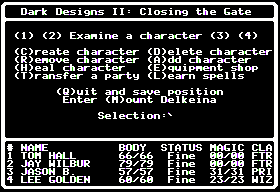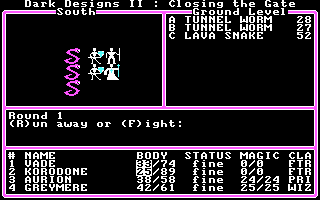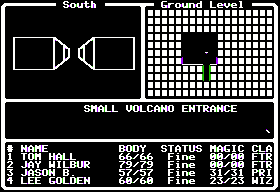Retro Replay Review
Gameplay
Dark Designs II: Closing the Gate retains the classic dungeon-crawling mechanics of its predecessor while introducing subtle refinements that streamline the experience. Players guide a party of adventurers through the winding tunnels of Mount Delkeina, engaging in turn-based combat, disarming traps, and solving environmental puzzles. The familiar interface makes for quick learning curves, while minor quality-of-life updates—such as giving spells clearer names—ensure that veterans and newcomers alike can jump in without a hitch.
(HEY YOU!! We hope you enjoy! We try not to run ads. So basically, this is a very expensive hobby running this site. Please consider joining us for updates, forums, and more. Network w/ us to make some cash or friends while retro gaming, and you can win some free retro games for posting. Okay, carry on 👍)
One of the most welcome innovations is the pooling of gold for the entire party. Gone are the days of micromanaging individual inventories and watching your rogue sit on a pile of coins they can’t spend. Now, whether you import your seasoned heroes from Dark Designs I or roll up fresh characters, you can invest in new equipment, potions, and spell scrolls as a group, which encourages more cooperative tactical decisions in combat.
The pacing of exploration and encounters is finely tuned. Early levels focus on establishing the core mechanics—searching for secret doors, negotiating with neutral factions, and refining your party’s composition—while later stages ratchet up the challenge with stronger monsters, cunning warlord lieutenants, and environmental hazards. The ability to import a party from the first game adds an extra layer of continuity, motivating completionists to replay the original before tackling the sequel.
Graphics
While Dark Designs II was released in an era dominated by VGA and early SVGA standards, its 2D tile-based graphics still hold nostalgic charm. The dungeon corridors are rendered with moody stone textures, flickering torchlight animations, and occasional color gradients that hint at deeper, more dangerous chasms below. Monster sprites are distinct enough to convey variety—from skeletal warriors to slithering subterranean beasts—though they lack the fluid animations of more modern titles.
The user interface remains largely text-driven, with concise menus and a top-down party status bar showing health, mana, and conditions. This no-frills approach can feel austere by today’s standards, but it accomplishes its goal: ensuring that players spend more time adventuring and less time wrestling with clunky UI elements. Spell icons, once cryptically labeled in the original, now come with clear names and brief descriptions, making it easier to plan your party’s magical arsenal.
Environmental variety is subtle but effective. As you descend farther into Mount Delkeina’s tunnels, wall textures shift from damp, mossy bricks to cracked obsidian and glowing runes. Occasional cutscenes—presented as static images with overlaid text—break up the dungeon grind and hint at the warlord’s growing power. Overall, while Dark Designs II won’t rival modern 3D engines, its graphics effectively serve the adventure, providing atmosphere without extraneous detail.
Story
Picking up where Dark Designs I: Grelminar’s Staff left off, Dark Designs II thrusts your party deeper into the realm of interdimensional menace. Having recovered the powerful staff of Grelminar, your heroes learn of a new threat: an evil warlord who seeks to build a monstrous army by harnessing a dimensional gate hidden within Mount Delkeina’s depths. The narrative drives you forward, blending classic high-fantasy tropes with occasional moral choices that influence NPC reactions.
The game’s dialogue is delivered through concise text windows, with each party member occasionally offering banter or strategic suggestions. Though character development is lighter than in some RPGs, key moments—such as rescuing captive villagers or discovering the warlord’s true identity—are given extra narrative weight through illustrated story panels. Sidequests pepper the main storyline, rewarding curious players with hidden lore and unique magical artifacts.
Dark Designs II balances its main quest pacing with optional exploration. You’ll overhear rumors in mountain encampments, uncover journals detailing the warlord’s past atrocities, and piece together a larger interdimensional conspiracy. These narrative threads converge as you close in on the gate itself, ensuring that the climax feels earned and the final confrontation carries both emotional and strategic stakes.
Overall Experience
Dark Designs II: Closing the Gate offers a well-crafted continuation for fans of old-school dungeon crawlers. Its blend of exploration, tactical combat, and light puzzle-solving creates a rewarding loop that keeps players engaged for dozens of hours. The minor enhancements—pooled gold, clearer spell names, and party import capability—shine brightest in prolonged playthroughs, underscoring the developers’ attention to fan feedback.
That said, the game’s roots show in its dated interface and the absence of voice acting or dynamic cutscenes. Newcomers accustomed to modern RPG conventions may find the presentation austere, and mapping out the complex tunnels of Mount Delkeina can be a trial for casual explorers. Still, those willing to invest the time will be rewarded with a rich world, challenging encounters, and a satisfying narrative payoff.
In the end, Dark Designs II succeeds as a classic sequel that respects its origins while delivering enough refinements to justify its existence. For buyers seeking a deep, old-school adventure with memorable dungeon crawling and a story that builds meaningfully on the first installment, Closing the Gate stands as a worthy and engaging quest.
 Retro Replay Retro Replay gaming reviews, news, emulation, geek stuff and more!
Retro Replay Retro Replay gaming reviews, news, emulation, geek stuff and more!








Reviews
There are no reviews yet.